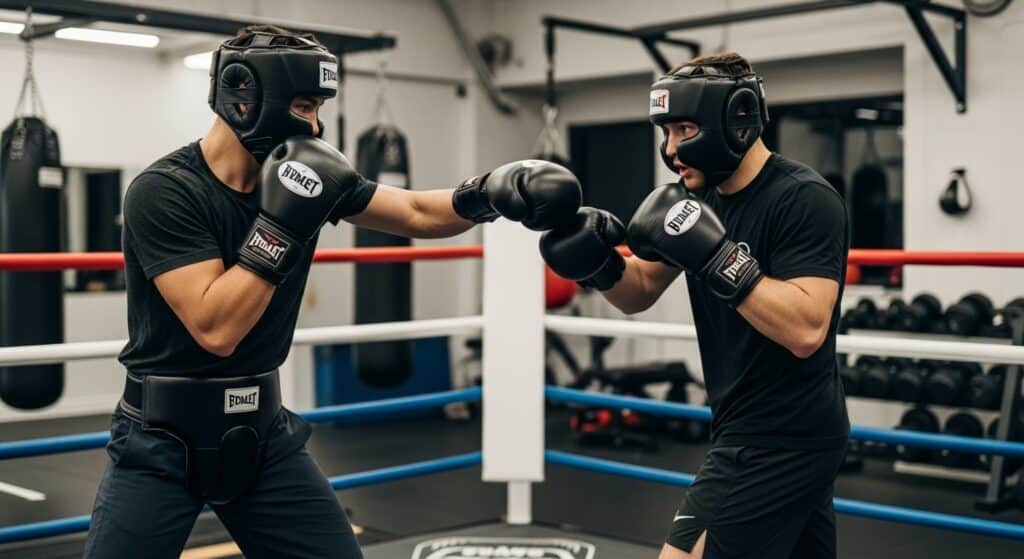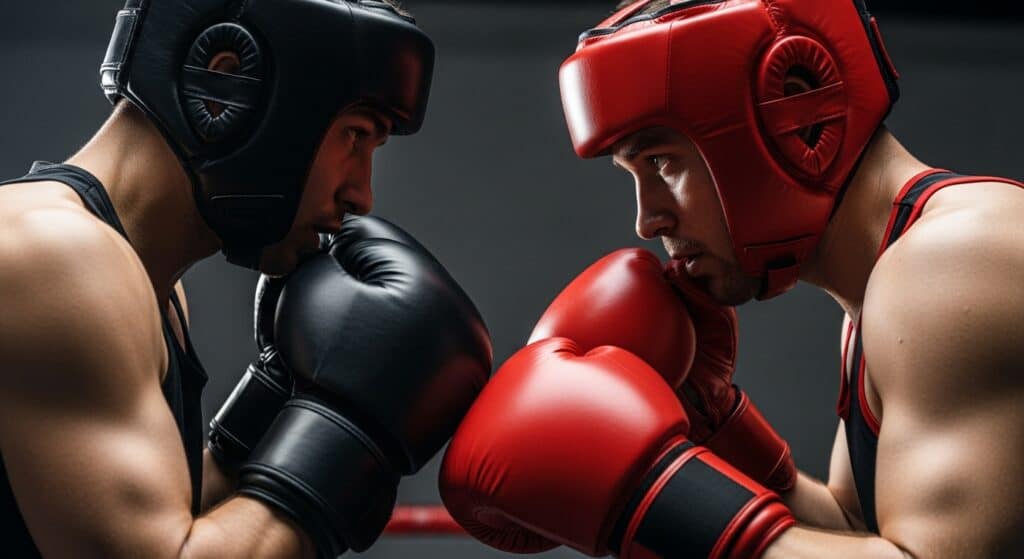“Champions are made from something they have deep inside them – a desire, a dream, a vision.” – Muhammad Ali. For those stepping into the ring, sparring etiquette is more than just rules. It’s about respect, safety, and effective boxing training.
When you lace up your gloves for a session, knowing the basics of sparring etiquette is key. It’s not just about throwing punches. It’s about creating a safe and productive environment for both you and your partner. This means being mindful of your opponent’s well-being and following guidelines for a beneficial boxing workout.

By following good sparring etiquette, you show respect to your fellow boxers and trainers. You also set yourself up for success in your training. So, let’s explore the essential rules every boxer should know for the best sparring sessions.
Key Takeaways
- Understand the importance of respect and safety in sparring.
- Learn the guidelines for a productive sparring session.
- Discover how good etiquette enhances your boxing training.
- Find out the essential rules for effective sparring.
- Improve your overall boxing experience with proper etiquette.
The Fundamentals of Boxing Sparring Etiquette
Boxing is not just about physical strength. It also needs a deep understanding of sparring etiquette. This etiquette makes the ring a safe and respectful place. It helps you improve your skills without distractions.
Following established norms makes your training sessions better and safer. It’s important to respect your partner’s limits and your own. High-intensity interval training is key, but knowing when to stop is just as important.
Why Proper Etiquette Creates Better Boxers
Good etiquette in boxing sparring makes you a better boxer. It helps you focus on technique and strategy, not risks. Boxing conditioning drills are vital, but so is doing them with control.
As you start with beginner boxing workouts, you’ll see the value of discipline and respect. These basics are the foundation for more advanced training. You’ll learn to use your skills in a respectful way.
The Difference Between Competition and Sparring
It’s important to know the difference between competition and sparring. Competition is about winning, but sparring is about learning and improving. Sparring lets you test your skills in a real situation, but in a controlled way.
Understanding the goals of sparring helps you stay focused during training. This mindset is essential for becoming a versatile boxer, ready for any situation.
Essential Boxing Workouts to Prepare for Sparring
To feel confident in the ring, you need a solid training plan for boxers. It should include the top exercises for boxing. Good preparation boosts your performance and gets you ready for sparring.
Conditioning Drills for Sparring Readiness
Conditioning drills are key for better endurance and stamina. Add boxing circuit training to your routine. This includes jumping rope, shadowboxing, and bag work. These exercises improve your heart health for tough sparring.
For instance, a conditioning session might have 3 rounds of jumping rope and 3 rounds of shadowboxing. You get little rest in between. This boxing circuit training raises your heart rate and sharpens your technique.
Beginner Boxing Workouts for First-Time Sparrers
Starting with sparring? You need workouts that are easy but build your basics. Start with stance work, footwork, and simple punches. These drills lay a strong foundation and boost your technique.
Beginners should also do strength and conditioning exercises. Work on your core strength with planks and Russian twists. This improves your stability and power.
Advanced Technique Practice for Controlled Sparring
More experienced boxers need to practice advanced techniques for better sparring. Work on complex combos, defense, and ring control. Sparring with different partners helps you adjust to various styles and boosts your skills.
To improve your sparring, do scenario training. Practice specific scenarios, like facing an opponent with a strong jab or a southpaw. This training sharpens your strategic thinking for better sparring.
Universal Sparring Rules in the Boxing Gym
To have a safe and effective sparring session, knowing the universal rules is key. These rules protect you and your sparring partner. They let you focus on improving your boxing fitness routine and learning new techniques.
Power Control: The Golden Rule of Sparring
Power control is very important in sparring. It affects the safety and success of the session. You should be careful with your punching power and adjust it based on your partner’s skill and your goals.
Adjusting Intensity for Different Partners
It’s important to change your intensity when sparring with different partners. For example, if you’re sparring with a beginner, you should slow down. This helps them learn without feeling too stressed.
Recognizing When You’re Going Too Hard
Knowing when you’re pushing too hard is also key. If your partner looks uncomfortable or can’t defend well, slow down. This ensures a safe and effective session.
Prohibited Targets and Techniques
It’s important to know what targets and techniques are not allowed in sparring. Strikes to the back of the head, neck, or below the belt are off-limits. So are techniques that could cause harm.

Round Management and Rest Periods
Managing rounds and rest periods is vital for a good sparring session. A round usually lasts 3 to 5 minutes. Then, you get a break to recover before the next round.
| Round Duration | Rest Period | Notes |
|---|---|---|
| 3 minutes | 1-2 minutes | Ideal for beginners or technique-focused sessions |
| 5 minutes | 1-2 minutes | Suitable for more advanced sparrers or conditioning-focused sessions |
By following these universal sparring rules, you can have a safe and beneficial sparring experience. It will improve your boxing fitness routine and help you master boxing.
Communication and Respect Between Sparring Partners
When you spar, it’s more than just a physical activity. It’s about building a partnership based on respect and understanding. The success of your sparring session depends on the communication and respect you show your partner. This is key for a safe, effective, and beneficial experience for both.

Pre-Sparring Conversations: Setting Expectations
Before you start, talk with your sparring partner. Discuss what you want to achieve, like working on defense or practicing techniques. Setting clear expectations helps tailor the session to meet your needs, making it more productive.
Non-Verbal Signals During Boxing Sessions
During sparring, non-verbal signals are very important. A tap on the shoulder or a hand signal can mean it’s time to pause or change the focus. Having these signals ready beforehand keeps the session smooth and ensures both partners are comfortable and aware of each other’s needs.
Post-Sparring Feedback and Gratitude
After sparring, it’s important to exchange feedback. Talk about what worked and what didn’t, giving constructive criticism to improve next time. Showing gratitude to your sparring partner is also key. It creates a positive atmosphere and encourages cooperation and respect.
| Aspect | Pre-Sparring | During Sparring | Post-Sparring |
|---|---|---|---|
| Communication | Discuss goals and expectations | Use non-verbal signals | Exchange feedback |
| Respect | Agree on the plan | Be mindful of your partner’s comfort | Show appreciation |
Safety Protocols Every Boxer Must Follow
Boxers at all levels must know and follow safety rules. Sparring is key in boxing training but has risks. By sticking to safety guidelines, you can lower these risks and make training better.
Mandatory Protective Equipment for Safe Sparring
Wearing the right gear is key for safe sparring. This includes a mouthguard, hand wraps, and a mouthguard. Making sure your gear fits right and is in good shape can greatly cut down injury risks.
| Protective Equipment | Purpose |
|---|---|
| Mouthguard | Protects teeth and mouth |
| Hand Wraps | Supports wrists and hands |
| Headgear | Protects against head injuries |
When to Call a Time-Out or Stop Completely
Knowing when to stop sparring is critical for your safety. If you feel pain or discomfort, stop right away. As a famous boxing coach once said,
“Safety is not just a protocol, it’s a mindset.”
Seeing injury signs early and acting fast can stop bigger problems. Always put your safety and your sparring partner’s first.
Gym-Specific Etiquette Rules to Respect
Every gym has its own rules and etiquette. Knowing these rules is important for being a good boxer. This means respecting your sparring partners, listening to the coach, and keeping the gym clean and safe.
Following these safety rules and etiquette helps make a positive and safe training space for everyone.
Conclusion: Building Your Reputation Through Proper Sparring Conduct
As you keep improving in the boxing gym, remember that how you spar is key to your boxing reputation. Following the advice in this article will boost your skills and gain respect from others.
Good sparring manners are vital for a safe and positive space for all. By sticking to the rules, you can better your technique and get in shape. Also, using boxing workout videos can help your training.
Your sparring conduct shows your character and commitment to boxing. Showing respect, control, and a desire to learn will make you a respected part of the boxing world.
FAQ
What are the most effective boxing workouts for improving sparring skills?
To boost your sparring skills, try high-intensity interval training (HIIT) and conditioning drills. These mimic the intensity of a real boxing match. Shadowboxing, heavy bag work, and pad work are great for this.Boxing circuit training also helps improve your endurance and agility. It’s a good way to mix up your routine.
How often should I spar to see improvement in my boxing skills?
How often you spar depends on your training plan and goals. Most boxers spar once or twice a week. This helps avoid overtraining and injury.Remember to balance sparring with technique practice and conditioning exercises. This keeps your training well-rounded.
What are some essential safety protocols to follow during sparring?
Always wear the right protective gear, like a mouthguard, gloves, and headgear. Talk to your sparring partner before and during the session. Stay aware of your gym surroundings.Knowing when to stop sparring is key for safety. It keeps the training environment safe for everyone.
How can I adjust my training to prepare for sparring with different partners?
To spar with different partners, work on being versatile. Focus on defense, footwork, and adjusting your intensity and technique quickly. Beginner boxing workouts can also help with adaptability and quick thinking.
What are some common mistakes to avoid during sparring?
Don’t fail to control your power or neglect to communicate with your partner. Always prioritize your safety and well-being. Follow your gym’s rules and guidelines.
How can I get the most out of my sparring sessions with a new partner?
Before sparring with a new partner, have a conversation about expectations and boundaries. Be open to feedback and willing to adjust your approach. Pay attention to non-verbal signals to stay in sync with your partner.
